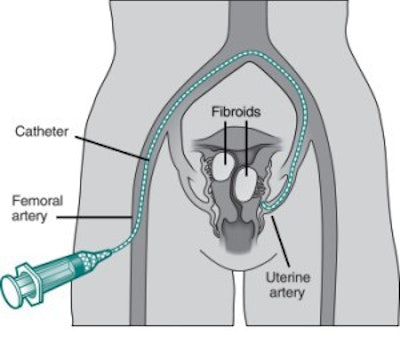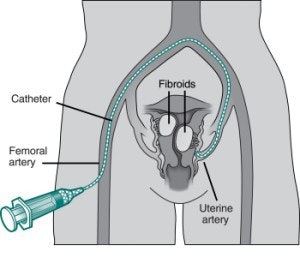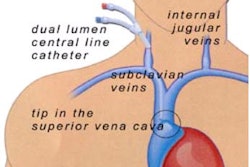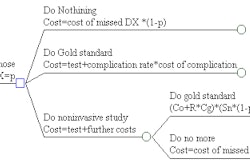
SALT LAKE CITY - Uterine fibroid embolization does not impair fertility, according to one-year follow-up results of the Canadian UFE Trial, reported last week at the Society of Interventional Radiology meeting.
In fact, the UFE (also known as uterine artery embolization) may actually enhance chances for a successful pregnancy, said Gaylene Pron, PhD, epidemiologist, department of public health sciences at the University of Toronto.
Pron said that 17 women who participated in the study of 550 women reported 19 pregnancies following the procedure. In an interview Pron said that "women in this trial were fully advised of the options and the uncertain effects of this treatment. About 30% of the women said that they were interested in future fertility." She said she thinks the pregnancy rates post-UFE are comparable with pregnancy rates following myomectomy.
All women in the study had symptomatic fibroids, and their average age was 42 (range 18-59 years). UFE was performed using polyvinyl alcohol particles (355-500 mm in size) and was bilaterally completed in 97% (n=538) patients. The one-year follow-up interview completion rate was 87% (n=485).
 |
| A basic diagram of a UFE procedure. A nick is made in the skin and a catheter is inserted into the femoral artery. The catheter, which is guided through the artery with real-time imaging, releases tris-acryl gelatin microspheres into the blood vessel feeding the fibroid. Image courtesy of the Society of Interventional Radiology. |
But Pron added that there is still no definitive answer for women faced with a choice between surgery and UFE. "That is the study that needs to be done: a randomized trial comparing fertility after UFE to fertility after myomectomy," she said.
Moreover, she contends there are no good data elucidating "fertility after myomectomy, and that has been the gold standard."
Shorter hospital stays
In a second SIR study, women who underwent uterine fibroid embolization for symptomatic disease had shorter hospital stays and returned to work significantly faster than women who underwent hysterectomy, said lead investigator Dr. James Spies, professor of radiology at Georgetown University in Washington DC.
Spies said "complications were also significantly less in the UFE group -- just 27.5% compared to 50% in the hysterectomy group." Complications reflect 12-month follow-up and "complications in both groups were very minor. Both procedures were well tolerated," he said.
The study represents part of the data collected for a 501(k) premarket notification to the Food and Drug Administration evaluating safety and efficacy of tris-acryl gelatin microspheres (EmboSphere Microspheres, Biosphere Medical, Rockland, MA).
Patients were assessed for bleeding, pelvic pain, pelvic discomfort, and urinary symptoms as well as quality of life following both procedures. "Obviously, one cannot compare bleeding differences between UFE and hysterectomy, but hysterectomy served as a comparative standard for pain, discomfort, urinary complications as well as quality-of-life issues," Spies said.
One hundred two women underwent UFE and 50 underwent hysterectomy. Interestingly, the UFE patients tended "to have larger uteri and more significant disease, often because they had refused hysterectomy several times," he explained.
UFE-treated women had an average hospital stay of less than a day (0.83 days) versus more than 2 days (2.3 days) for hysterectomy patients. The UFE-treated women returned to work in an average of 10.7 days compared to 32.5 days for the women undergoing hysterectomy.
Spies said his data, combined with the fertility data from Pron, make a compelling case for the efficacy of UFE. He said the procedure should be offered to women seeking to preserve fertility "if they are planning to start a family in more than two years. Women who are interested in pursuing pregnancy in a shorter time, should be referred for myomectomy."
Spies also believes the uterus is likely to "return to normal" more quickly after surgical excision than after UFE, he said.
Commenting on both studies was Dr. John Lipman of the Center for Minimally Invasive Therapy in Atlanta. He agreed that UFE has several advantages over surgery. Lipman, who has a large UFE practice, also thinks that UFE has a positive effect on fertility, but adds that it is only an "impression." He concurred that only a randomized trial can definitively answer the question. Until then, he said, "we have to rely upon results such as those from the Canadian study."
UFE and pregnancy
Pron said women in the study were "advised to wait for 3 or 4 months after the procedure before attempting to conceive, and this is roughly the same advice given after myomectomy." There were three spontaneous early abortions and one therapeutic abortion among the 19 pregnancies. "There have been 14 live births so far and one more is expected next month," she said.
Interestingly, 13 of the 15 women had "a history of prior miscarriage -- one woman had 9 prior miscarriages. Twelve of the women had no babies before the procedure," she said. That suggests that untreated fibroid disease may "impair fertility." Eighteen of the 19 pregnancies were "achieved without fertility treatments, one was achieved using in vitro fertilization," she said.
Ten women were offered a trial of labor and six women completed successful vaginal deliveries. "I think it is encouraging that these women were offered a trial of labor, but I think the general feeling is that these women should be managed in the same way as VBAC women, with labor closely monitored," Pron said.
All of the women in the study had symptomatic fibroids, and their average age was 42 (range 18-59). Uterine artery embolization was performed using polyvinyl alcohol particles of 355 -500 mm., and was bilaterally completed in 97% (n=538). The one-year follow-up interview completion rate was 87% (n=485).
By Peggy PeckAuntMinnie.com contributing writer
April 1, 2003
Related Reading
Women respond well to UAE in the long term, SIR study shows, March 29, 2003
GE rolls out Innova 4100, March 28, 2003
MR helpful in managing patients with uterine fibroids, January 23, 2003
Cheaper UAE edges out hysterectomy for uterine fibroid treatment, January 17, 2003
Copyright © 2003 AuntMinnie.com



















